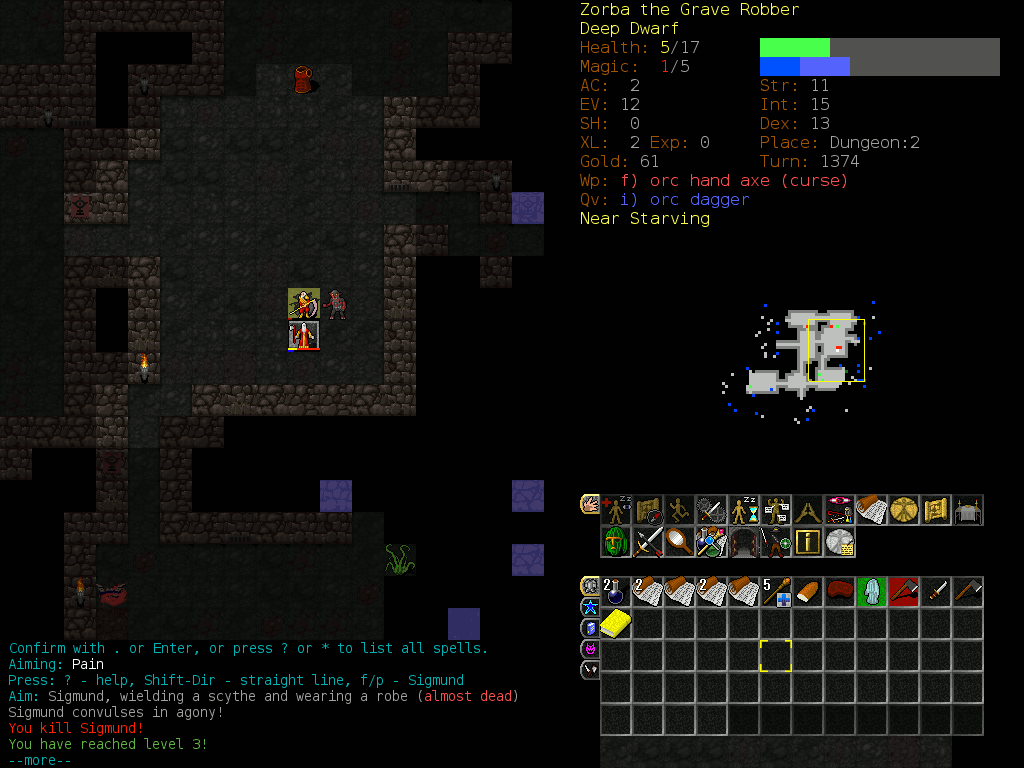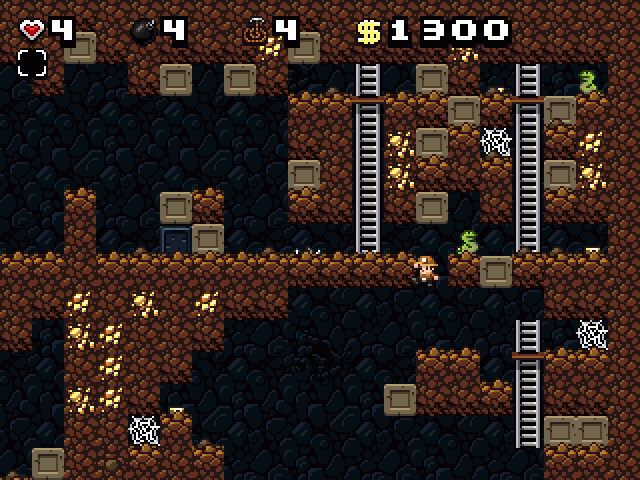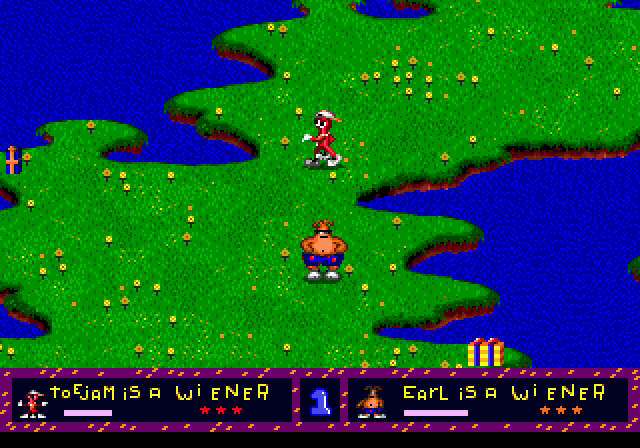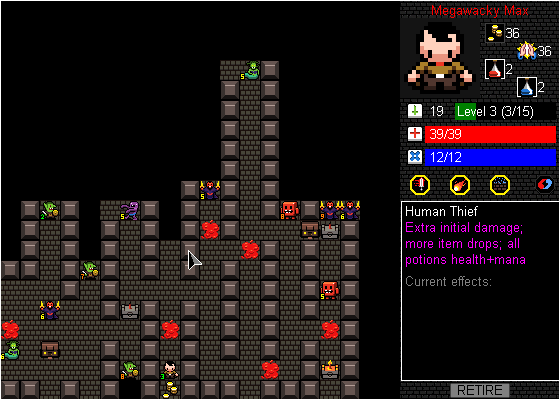Roguelikes: The Misnamed Genre
2011, April 25th 4:47 PMRecently, I've been playing a game called Dungeon Crawl: Stone Soup. You should play it. It's good.
DCSS is a game about searching a dungeon for a magical McGuffin named The Orb of Zot. You choose a species and a background, get starter gear, and delve into the furthest depths of the unmapped, unexplored, randomly generated, extremely dangerous dungeon complex. There are about a dozen major areas in the world, including The Hive, The Shoals, The Abyss, and Hell itself, plus a large number of minor areas like the Ecumenical Temple and Erinya's Garden, many of which may or may not even exist. Along the way you'll find magical armor, scrolls, wands, and potions, none of which are identified. Putting on an unidentified ring could result in the discovery of a +5 Ring of Slaying (really goddamn good), it could result in "well, now you're wearing a ring, and you still don't know what it does", or it could result in discovering you've just donned a Cursed Ring of Hunger and you're about to starve to death if you can't get rid of it immediately.
Death, in DCSS, is a major event. When you die, that's it. You're done. That character is deleted. There are no save points, there is no reloading. Want to run full speed through the Hall of Blades just to find out what happens? What happens is that you get chopped to bits by the magical weapons filling the Hall of Blades and now you have to start over.

DCSS isn't a unique game. It is, however, possibly the most modern example of its genre, known as Roguelikes. The original game Rogue was released way back in 1980, sporting a text-based interface, randomized items, a randomized dungeon, and permadeath. Rogue inspired a similar game called Hack, which, itself, inspired a game called Nethack, a game notable enough that it occasionally displaces Rogue as the name of the genre. A few years later Angband was developed, then Linley's Dungeon Crawl, which was abandoned and eventually resurrected as Dungeon Crawl: Stone Soup . . . sporting a text-based interface, randomized items, a randomized dungeon, and permadeath.
Those are the big names, at least. The Roguelike genre is very conducive to small projects. Its text-based "graphics" mean that any game developer can write up a little Roguelike of their very own, and the code behind Roguelikes tend to be simple to start with, albeit complicated to continue. There are easily a dozen major Roguelikes still in production, with dozens or perhaps hundreds that have been abandoned over the years. They all follow approximately the same formula: you choose a species and a background, you enter a randomly-generated dungeon with text-based art, you travel deep into the earth, using random unidentified magical items to survive until you find a magical relic which you cart back up to the surface and you win.
Except . . . they don't all follow that formula. They almost do. But not quite.

DCSS, for example, has a graphical mode. Not the prettiest graphics in the world. But it's graphics. So that kind of breaks the formula. And while it's not mandatory to use, DCSS has a Tower Defense mode known as Zot Defense, and a canned hand-made dungeon mode known as Dungeon Sprint. Which aren't really Roguelikes, because they're not about finding that magical relic in a randomly generated dungeon. But they sort of are, because they use all the same items and monsters and behaviors.
There's also Desktop Dungeons, which breaks the formula further. Most Roguelikes take many hours to beat, even if you know what you're doing. Desktop Dungeons takes about fifteen minutes per run. And it's got graphics – in fact, it has mandatory graphics. And sound. And there's no such thing as a cursed or unidentified item. But it's still a Roguelike. Sort of.
And there's Dwarf Fortress, which . . . well, it's got ASCII art. And randomly generated levels. That's all normal. But instead of controlling an adventurer, you control an entire town of dwarves, mining out a civilization into a cliff side or a convenient hill (or the frozen tundra, if you're looking for a challenge). And you're not trying to find a magical artifact. You're just trying to survive. Or maybe you're trying to make the world's largest elephant combat pit. Or maybe you're trying to build a digital computer out of pipes and gears and dwarves. It's not really a Roguelike. But it's within a stone's throw.
100 Rogues is an iPhone game, graphics and all. ADOM has a world map and multiple dungeons. Spelunky is a sidescroller action game. Toejam and Earl is about a pair of aliens repairing a crash-landed spaceship in order to go back home. There are so many exceptions, so many alternatives, so many branches, so many cases where people can't decide if a game is a roguelike or not, that I can only come to one conclusion:
The term "Roguelike" is not a well-defined term.

We've been trying to define "Roguelikes" based on what the game includes. Deep dungeons, random levels, cursed artifacts. But non-game genres aren't define that way. Imagine trying to divvy up movie genres based on their components. This movie has a car, so it must be a car movie. No, but wait, it has guns also! It must be a guns movie! No, actually, it's "The Godfather", and it's a drama movie. Or maybe it's a crime movie, or a thriller, or even a Mafia movie. But it contains cars and guns, and it's about drama and the Mafia.
Roguelikes aren't about dungeons. They're not about text-based graphics, or random artifacts, or permadeath.
Roguelikes are about complexity.
Roguelikes are about handing you a set of pieces. Roguelikes say, hey, these simple parts, when put together in this fashion, will have this obvious effect. And then they hand you more pieces, and you get to figure out the best way to combine those pieces.
Roguelikes are about using an unpredictable toolkit with complex interactions in order to overcome unpredictable challenges.
For example, there's an item in DCSS known as the Scroll of Immolation. When you read it, it blows up in your hands. Sounds kind of crappy, right? Now let's imagine you're wearing a bunch of fire resist gear, and you're in the Ice Dungeon, and you're being swarmed by a bunch of small ice critters. Read scroll, scroll blows up, you're immune, monsters aren't. Of course, this isn't the kind of thing you can plan for. You might not have that scroll. Chances are good you won't have a bunch of fire resist gear in the Ice Cave. And you're more likely to be attacked by a few big monsters than swarmed by small monsters. So what I've just described is not likely to be useful.
But DCSS contains dozens, if not hundreds, if not thousands of tricks you can use, and in any serious game you'll be close to death many times. If you can't find a good trick to survive, you'll die. The way to beat a Roguelike isn't to memorize all the tricks, it's to learn how to come up with ideas on the fly.
In Dwarf Fortress, your game will depend partially on what natural resources are available, and in what quantities. You can't always determine this early on in the game. You might reach the mid-game and run out of iron. Whoops. Time to find more iron, or learn to do without. In Desktop Dungeons, you never know quite which monsters you'll run into, which deities will be available, which spells and items you can get ahold of. These aren't traditional Roguelike games, but the core mechanic, the critical part that makes them feel Roguelikey, is preserved perfectly.

Once we acknowledge this potential new definition of Roguelikes, we start seeing it crop up in surprising places. Civilization 5 has a military that relies on finding certain important resources in order to build the best units. If you're lucky enough to find a lot of them, you might change your strategy to lean towards military conquest. If you find few of them, you might take a more defensive position, or use units that don't require iron or horses. Dominions 3, an excellent but obscure multiplayer turn-based strategy, is thoroughly laced with this – finding an important magical site, or a powerful recruitable independent mage, can change your entire long-term strategy if you're clever enough to recognize it. And here's the most unlikely comparison you'll hear in a while – Super Smash Bros Brawl multiplayer is like a Roguelike! A lot of the multiplayer strategy is seeing special items quickly and coming up with a good way to use them, or seeing what's being used against you and learning how to counter it. Compare a SSBB Pokeball and an unidentified Nethack potion or scroll. Unpredictable toolkit, unpredictable challenges.
And of course, Nieuwe Aarde, the game I've been putting more work into, is intended to be a Roguelike by this definition. I've been putting a ton of thought into how to make it more Roguelikeish – right now it frankly does a very bad job of being a Roguelike – and I think I have good ideas. Once I have the time, you'll be seeing more on this front.
There's only one problem. The word "Roguelike" is already taken. And the people who make Roguelikes would probably be a bit peeved by my claim that Super Smash Bros Brawl is a Roguelike. And worst of all, Rogue itself only has this property to a limited extent – there aren't many items, there aren't many abilities, there aren't multiple races or multiple character classes. So I think it's time to coin a new term . . . but I've had no luck coming up with a good term. My best option so far is "Highly Emergent Games", which sounds like a phrase you'd hear coming out of Zynga. Not ideal.

________ are about using an unpredictable toolkit with complex interactions in order to overcome unpredictable challenges.
I've defined a new genre of game. What do you think it should be called?

